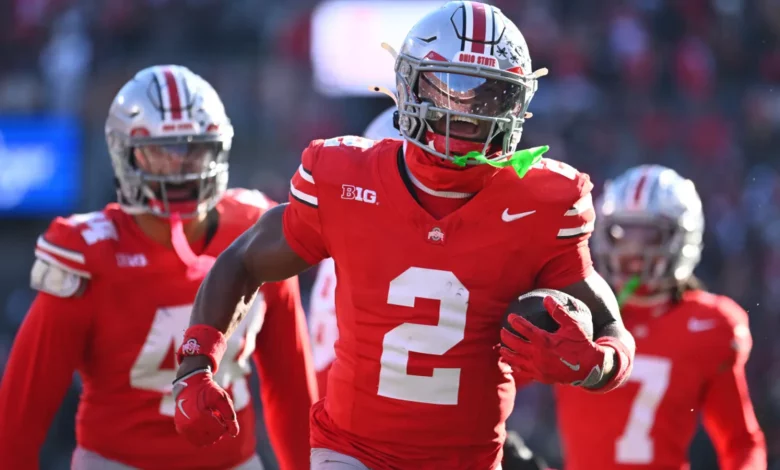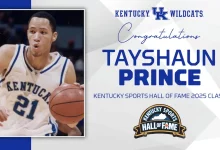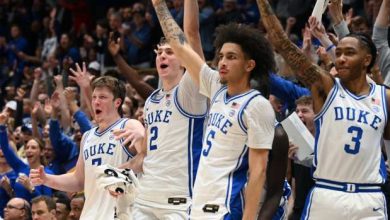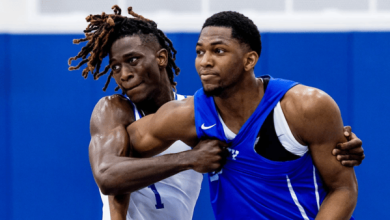Caleb Downs believes Ohio State’s defense has the potential to be just as strong as last year’s, showcasing confidence in the team’s defensive capabilities and future performance.

In the realm of college football, defense often serves as the backbone of a successful team, providing the stability and resilience necessary to contend for championships. Caleb Downs, a highly regarded player and leader for Ohio State, has expressed confidence that the Buckeyes’ defense can match or even surpass the standards set by last year’s unit. This statement is not merely optimistic rhetoric but reflects a strategic belief rooted in the team’s talent, coaching, development trajectory, and organizational culture. Exploring this perspective in detail reveals the intricacies of Ohio State’s defensive identity, the factors contributing to last year’s success, the changes and continuity heading into this season, and the broader implications for the Buckeyes’ championship aspirations.
The Significance of Caleb Downs’s Confidence
Caleb Downs’s statement embodies a crucial element of team psychology and leadership. When a prominent player confidently asserts that the defense can replicate or improve upon a previous elite performance, it signals internal belief and a collective mindset geared toward excellence. Such confidence can boost team morale, foster a culture of high standards, and influence the confidence of coaching staff and fans alike.
Moreover, Downs’s position as a leader and a highly talented player adds weight to his words. His confidence is likely rooted in a thorough understanding of the team’s preparations, talent development, and tactical adjustments. For fans and analysts, his statement provides a positive outlook, reinforcing the narrative that Ohio State remains a formidable defensive unit.
A Recap of Ohio State’s Defensive Performance Last Year
To appreciate the significance of this confidence, it is essential to analyze the performance and characteristics of Ohio State’s defense last year. The Buckeyes’ 2023 defense was widely regarded as one of the top units in college football, characterized by:
Stout Run Defense: Ohio State consistently limited opponents’ rushing games, often among the best in the nation for rushing yards allowed per game. This success was driven by disciplined line play, effective linebacking, and gap control.
Pass Defense and Pass Rush: The Buckeyes employed a versatile pass rush, generating pressure without solely relying on blitzes. Their secondary demonstrated sharp coverage skills, intercepting passes and limiting big plays.
Turnover Creation: The unit excelled at forcing turnovers, including interceptions and fumble recoveries, which often shifted momentum in Ohio State’s favor.
Tackling and Discipline: Ohio State defenders showcased excellent tackling fundamentals, reducing opponents’ yards after contact and minimizing explosive plays.
Coaching and Scheme: Under the guidance of defensive coordinator Jim Knowles, Ohio State implemented a scheme emphasizing aggressive pass rushes, versatile coverage schemes, and disciplined gap control, which proved effective throughout the season.
This combination of talent, scheme, and discipline translated into a defense that ranked among the best nationally, often ranked in the top 10 for various defensive metrics.
Factors Contributing to Last Year’s Defensive Success
Several elements contributed to Ohio State’s defensively dominant season, which Caleb Downs now seeks to emulate or surpass:
Elite Talent Acquisition: Ohio State consistently recruits top-tier defensive players, including high four- and five-star prospects. The 2023 roster was no exception, featuring dynamic linebackers, talented defensive backs, and disruptive defensive linemen.
Player Development: The coaching staff’s ability to develop raw talent into disciplined, scheme-fit players played a significant role. Individual improvements in coverage skills, pass rushing, and tackling techniques contributed to overall success.
Innovative Scheme: Jim Knowles’s scheme emphasized versatility and unpredictability, confusing opponents and creating turnovers. The defensive game plan adapted effectively to different offensive styles.
Leadership and Cohesion: Experienced upperclassmen and leadership figures fostered a culture of accountability, discipline, and high effort—key ingredients for a top-tier defense.
In-Game Adjustments: Ohio State’s ability to adapt during games, making tactical adjustments based on offensive tendencies, helped limit big plays and sustain defensive performance.
Health and Depth: Maintaining player health and having quality depth allowed Ohio State to sustain high-level play throughout the season, even during injuries or fatigue.
The Challenges and Opportunities Moving Forward
While Ohio State’s defense last year was highly successful, replicating or exceeding that performance involves navigating new challenges and leveraging opportunities for growth.
Challenges include:
Graduation and NFL Draft Departures: Key players from last year’s defense might have moved on to the NFL, creating potential gaps in talent, experience, and leadership.
Evolving Offensive Schemes: Opponents will analyze last year’s game tape and adjust their offensive strategies, requiring Ohio State to innovate and adapt.
Increased Competition: The Big Ten conference continues to strengthen, with rival programs investing in talent and schemes that challenge Ohio State’s defenses.
Injury Risks: The physical nature of defense makes injuries inevitable; depth and player development are crucial to maintaining high performance.
Opportunities for improvement include:
Emerging Talent: Freshmen and underclassmen can step into key roles, bringing new energy and skills.
Scheme Refinements: Defensive coordinators can tweak schemes to counter evolving offensive trends, exploiting weaknesses.
Player Development: Continued focus on coaching, film study, and conditioning can elevate existing players’ performances.
Leadership Development: Cultivating leadership within the roster fosters accountability and resilience.
The Role of Coaching and Player Development
A critical factor supporting Caleb Downs’s optimism is Ohio State’s coaching staff’s reputation for developing defensive talent and implementing effective schemes. Defensive coordinator Jim Knowles’s approach emphasizes aggressiveness, versatility, and disciplined execution, which can be further refined with offseason adjustments.
Player development efforts include:
Technical Skills: Improving tackling, coverage, and pass-rushing techniques.
Football IQ: Enhancing understanding of schemes and opponent tendencies.
Physical Conditioning: Ensuring players are physically prepared for the rigors of a demanding schedule.
Mental Toughness: Building resilience to withstand high-pressure situations.
The combination of coaching expertise and player growth creates a strong foundation for replicating or surpassing last year’s defensive success.
The Impact of Leadership and Culture
Leadership within the defense is pivotal. Caleb Downs, as a leader, embodies confidence and accountability, inspiring teammates to perform at high levels. A culture emphasizing discipline, relentless effort, and continuous improvement fosters consistency and resilience, which are critical for maintaining elite defensive standards.
Ohio State’s culture of excellence, reinforced through team rituals, accountability measures, and a focus on fundamentals, underpins sustained success. This environment supports players in reaching their potential and executing schemes effectively.
Strategic Adjustments and Future Outlook
To ensure that Ohio State’s defense remains as good as last year or better, strategic adjustments might include:
Innovating Schemes: Incorporating new formations or blitz packages to keep offenses off-balance.
Emphasizing Turnover Creation: Continuing to prioritize forcing turnovers through aggressive coverage and ball-hawking techniques.
Utilizing Technology: Leveraging film analysis, biometric data, and analytics to identify weaknesses and tailor training.
Enhancing Special Situations Play: Improving third-down stops, red-zone defense, and two-minute drills.
The coaching staff’s ability to adapt and evolve will be critical in overcoming challenges and capitalizing on opportunities.
Broader Implications for Ohio State’s Season and College Football
If Ohio State’s defense can indeed match or exceed last year’s performance, the impact on the team’s overall success and national championship aspirations would be significant:
Winning Close Games: A strong defense can be decisive in tight contests, especially against top-ranked opponents.
Maintaining Consistency: Defensive stability allows the offense to operate with confidence, knowing they have reliable support.
Building Momentum: Defensive dominance can energize the team and fan base, creating a positive feedback loop.
Recruitment Boost: Demonstrable defensive excellence attracts high school prospects, ensuring sustained talent influx.
National Recognition: A top-ranked defense elevates Ohio State’s reputation, influencing playoff seeding and media perception.
Confidence Rooted in Strategy and Culture
Caleb Downs’s belief that Ohio State’s defense can be as good as last year reflects a deep understanding of the team’s talent, coaching, and organizational culture. It embodies a strategic confidence that, with continued development, tactical evolution, and leadership, Ohio State can sustain its elite defensive performance. Such belief is vital for motivating teammates, inspiring coaches, and rallying fans around a common goal of excellence. As the Buckeyes prepare for the upcoming season, that confidence serves as both a testament to their capabilities and a challenge to uphold the standards of a storied program. If they can meet or surpass last year’s standards, Ohio State will once again position itself as a formidable force in college football, with a defense that can carry them deep into postseason play and potentially secure another national championship.









